Philae Temple: The Jewel of the Nile
Nestled on a tiny island in the middle of the Nile River, Philae Temple, also known as the Jewel of the Nile, captivates the hearts of countless travellers. With its unique architecture and intriguing history, this ancient Egyptian temple is a must-visit destination.
Join us as we explore the beauty and significance of Philae Temple, and discover why it continues to be a favourite among tourists.
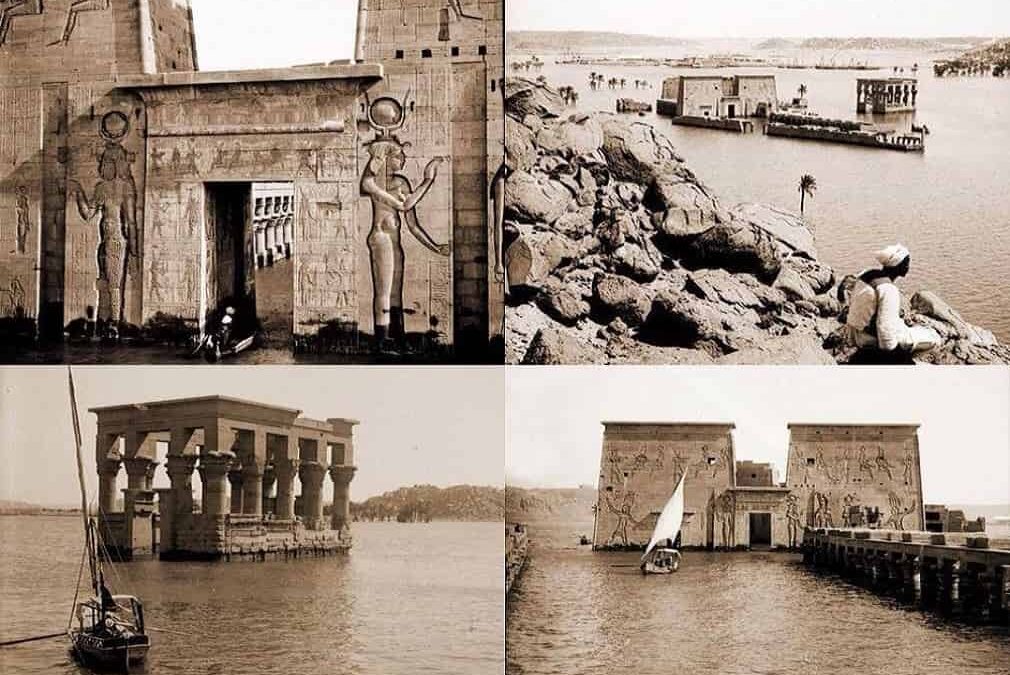
Overview of Philae Temple and its Significance in Ancient Egyptian History
The Philae Temple, also known as the Temple of Isis, is a stunning archaeological site on the Philae island in Egypt. It holds immense significance in ancient Egyptian history and continues to captivate visitors with its beauty and rich cultural heritage.
Built during the Ptolemaic dynasty and completed during the Roman period, the Philae Temple was dedicated to the goddess Isis, the wife of Osiris and the mother of Horus. It served as an important religious centre and a place of pilgrimage for worshippers of Isis and Horus.
The temple's layout is a testament to the architectural skill of the ancient Egyptians. It features towering pylons, expansive courtyards, a hypostyle hall with beautifully carved columns, and a sanctuary where the sacred statues of Isis and Horus were once housed. The reliefs and carvings within the temple depict religious rituals, mythological scenes, and the glorification of the goddess Isis.
The temple was transformed into a Christian church during the Christian period, and some of the original reliefs were defaced. The building of the Aswan Dam posed a significant threat to the temple's preservation. Still, luckily, a multinational rescue operation was undertaken to relocate the temple to nearby Agilkia Island, ensuring its survival.
Since its reopening, the Philae Temple has become a popular tourist destination recognized as a UNESCO World Heritage Site. It serves as a testament to the ancient Egyptian civilization's architectural prowess, religious beliefs, and cultural legacy.
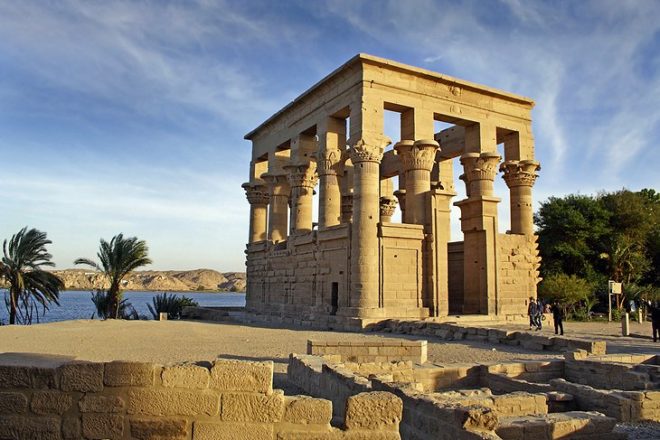
Introduction to the location and beauty of the temple on the island of Philae
The Philae Temple is an exquisite ancient Egyptian temple located on the island of Philae in Upper Egypt. Situated near Aswan, this picturesque setting makes the temple a true jewel of the Nile. Emerald-green waters surround the island, and the temple stands proudly amidst lush vegetation, creating a serene and enchanting atmosphere for visitors.
The temple's location on the island of Philae further adds to its allure. The island was considered sacred by ancient Egyptians and was believed to be the burial place of the god Osiris. This mythological connection adds a sense of mystique to the temple and enhances its significance in Egyptian history and culture.
The beauty of the Philae Temple lies not only in its location but also in its architectural splendour. The temple is a masterpiece of ancient Egyptian artistry, featuring grand pylons, expansive courtyards, a magnificent hypostyle hall, and an ornate sanctuary. These architectural elements, adorned with intricate carvings and reliefs, showcase the artistic and engineering prowess of the ancient Egyptians.
The serene island setting and the temple's magnificent architecture create a captivating experience for visitors. As one explores the temple, they are transported back in time, immersed in ancient Egypt's rich history and cultural heritage.
Today, the Philae Temple is open to the public and has been designated as a UNESCO World Heritage Site. It is beauty and historical significance continue to attract tourists worldwide, allowing them to witness the ancient splendour and connect with the mystical past of Egypt.
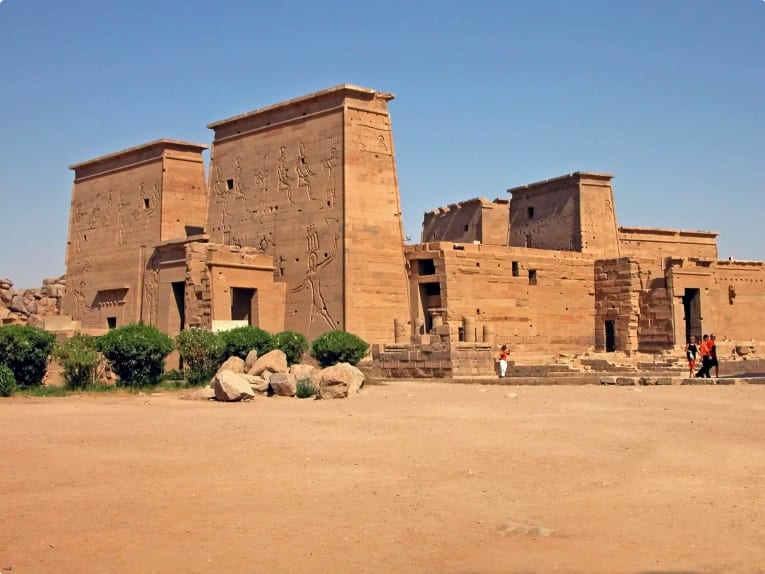
History of Philae Temple
Construction and dedication of the temple to the goddess Isis
The Philae Temple, located on the island of Philae, holds great significance in ancient Egyptian history. The temple's construction was dedicated to the goddess Isis, who was revered as the supreme mother and the goddess of love, fertility, and magic. The temple was built during the Ptolemaic period, around 237 BC.
The temple's construction and dedication to Isis were part of a larger religious and political agenda. The Ptolemaic rulers aimed to strengthen their position in Egypt by aligning themselves with traditional Egyptian religious beliefs and incorporating them into their Hellenistic culture. This strategy helped legitimize their rule and gain the local population's support.
The temple was designed as a grand complex, reflecting the important role of Isis in Egyptian mythology and society. It featured elaborate pylons, courtyards, a hypostyle hall, and a sanctuary dedicated to the worship of Isis and her son Horus. The temple's architecture and design were meant to evoke a sense of awe and reverence, creating a sacred space for religious ceremonies and rituals.
The temple's reliefs and carvings depicted various religious rituals and mythological scenes, showcasing the goddess Isis's importance and role in ancient Egyptian mythology. These intricate and detailed carvings helped bring the ancient Egyptians' stories and beliefs to life, visually representing their religious practices and beliefs.
Over time, the temple underwent various transformations and adaptations. It was converted into a church during the Christian period, and some of the reliefs were altered or covered. Despite these changes, the temple's original purpose and significance remained, and the dedication to the goddess Isis continued to be honoured.
Today, the Philae Temple stands as a testament to the ancient Egyptian civilization, showcasing the rich cultural heritage of Egypt and attracting visitors from around the world. It was relocated during the construction of the Aswan Dam in the 1960s and 1970s to preserve it from the rising waters of the Nile. In 1979, it was officially reopened to the public and recognized as a UNESCO World Heritage Site, ensuring its preservation for future generations to appreciate and admire.
The temple's role in the worship of Isis and her son Horus
The Philae Temple played a significant role in the worship of the Egyptian goddess Isis and her son Horus. According to ancient Egyptian mythology, Isis was considered the ideal mother and wife, and she was widely revered for her wisdom, healing abilities, and magical powers. The temple was dedicated to Isis as a symbol of her importance and a place of worship for her followers.
The temple’s design and layout reflected the religious rituals and beliefs associated with the worship of Isis and Horus. It comprised various sections, including pylons, courtyards, a hypostyle hall, and a sanctuary. The pylons were monumental gateways that marked the entrance to the temple and served as a visual representation of the divine realm. The courtyards provided space for gatherings and religious ceremonies. At the same time, the hypostyle hall was a grand hall with rows of columns that symbolized the heavens, where the gods were believed to reside. The sanctuary was the most sacred part of the temple and housed the cult image of Isis or her symbolic representation.
Within the temple, reliefs and carvings depicted religious rituals and mythological scenes related to the worship of Isis and Horus. These intricate and detailed artworks provided a visual representation of the religious beliefs and practices of the ancient Egyptians. They often depicted Isis nursing her son Horus, symbolising her role as a protective and nurturing mother.
Over time, the temple underwent various changes and renovations under the influence of the Ptolemaic and Roman periods. These changes may have included adding new religious elements and integrating other deities into the temple’s worship.
Today, the Philae Temple is a testament to ancient Egyptian civilisation's rich history and cultural significance. It has been carefully preserved and is open to the public, allowing visitors to marvel at its architectural beauty and explore the fascinating world of ancient Egyptian mythology and religion. As a UNESCO World Heritage Site, the temple continues to captivate and educate visitors worldwide.
Influence of the Ptolemaic and Roman periods on the temple's development
During the Ptolemaic period, which began after the conquest of Egypt by Alexander the Great, the Philae Temple underwent significant renovations and expansions. The Ptolemaic rulers revered Egyptian deities, especially the goddess Isis, who was worshipped as a personification of motherhood, love, and magic. The temple became a centre for the worship of Isis, and large-scale construction projects were undertaken to enhance and beautify the sacred site.
The Ptolemaic kings added monumental gateways known as pylons to the temple's entrance, creating a grand and imposing façade. These pylons were decorated with intricate reliefs and carvings that depicted scenes from the religious rituals and mythological stories associated with the cult of Isis and her son Horus.
During the Roman period, which followed the conquest of Egypt by the Roman Empire in 30 BCE, the Philae Temple continued to be revered as a holy site. The Romans brought their own architectural and artistic influence to the temple. They added new colonnades and porticoes, expanding the temple complex and enriching its architectural design.
The religious traditions associated with the temple also evolved during this period. The worship of Isis and Horus merged with the veneration of Roman emperors, resulting in a syncretic form of religious practice. The temple became a place of worship for Egyptian and Roman deities, reflecting the multicultural nature of the Roman Empire.
Today, the Ptolemaic and Roman influences can still be seen in the architecture and reliefs of the Philae Temple. Blending Egyptian, Greek, and Roman styles showcases the cultural exchange and artistic fusion during this period. The temple is a testament to ancient Egypt's rich and complex history and its lasting impact on the world.

Architecture and Design of Philae Temple
Description of the temple's layout and key features, including pylons, courtyards, hypostyle hall, and sanctuary
The Philae Temple is a magnificent structure located on the island of Philae in Egypt. It is revered as one of the most significant ancient Egyptian temples dedicated to the goddess Isis. The temple's layout is designed to reflect the religious architecture of the time, with various key features adding to its grandeur.
The temple’s entrance is marked by two towering pylons, which were intricately carved and decorated with reliefs showcasing scenes from ancient Egyptian mythology. These pylons served as a visual barrier between the outside world and the sacred grounds of the temple.
Upon passing through the pylons, visitors would enter the temple’s courtyards, which were spacious and lined with columns. These courtyards served as gathering places for religious ceremonies and rituals, and they were often adorned with statues and offering tables.
One of the temple's most impressive and important sections is the hypostyle hall. This hall features a forest of columns, with towering pillars adorned with intricate carvings of hieroglyphs and mythological scenes. The hypostyle hall was used for important religious ceremonies and gatherings and visualised the divine power associated with Isis.
At the heart of the temple is the sanctuary, which is the most sacred area of the temple. Inside the sanctuary, an elaborate shrine housed the image of the goddess Isis and acted as a focal point for worship and offerings. The sanctuary was believed to be the dwelling place of the goddess and was accessible only to high-ranking priests.
Today, visitors can explore the temple and marvel at its architectural brilliance and artistic details. The Philae Temple is a testament to the greatness of ancient Egyptian civilization and continues to captivate visitors with its stunning layout and key features.
UNESCO recognised the significance of the temple, and it has been diligently preserved, ensuring that future generations can appreciate its beauty and understand its historical importance.

Examination of the reliefs and carvings found within the temple, depicting religious rituals and mythological scenes
The Philae Temple is renowned for its intricate and beautifully preserved reliefs and carvings that depict religious rituals and mythological scenes from ancient Egyptian history. These artistic representations provide valuable insights into the religious beliefs and practices of the time.
One of the most prominent features of the temple is the depiction of the goddess Isis, to whom the temple was dedicated. Isis was a highly revered figure in ancient Egyptian mythology and was associated with fertility, protection, and motherhood. The reliefs show her in different forms, such as a mournful widow mourning the death of her husband Osiris and a nurturing mother with her son Horus. These portrayals highlight her role as a divine mother figure and symbolize the cyclic nature of life and death.
The reliefs also depict various religious ceremonies and offerings to the gods. These scenes provide valuable insights into ancient Egyptians' religious rituals and practices, including the importance of animal sacrifices, offerings, and the belief in an afterlife. The carvings also depict mythological stories and divine beings such as Ra, Amun, and Hathor, showcasing the complex pantheon of gods worshipped during that time.
The preservation of these reliefs and carvings is of utmost importance to scholars and historians as they provide a window into the ancient world and allow us to better understand the ancient Egyptians' religious beliefs, myths, and rituals. Efforts have been made to document and protect these artistic treasures, ensuring their continued appreciation for future generations.
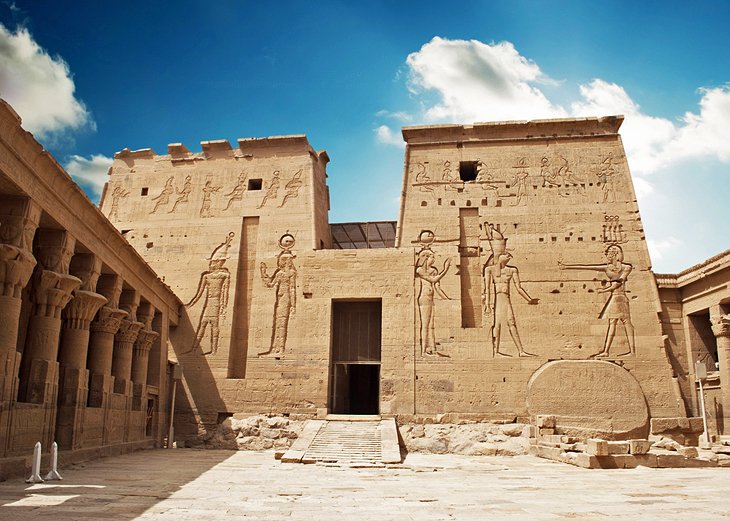
Christian Era and Preservation Efforts
Transformation of the temple into a Christian church during the Christian period
During the Christian period, the Philae Temple underwent a significant transformation.
As Christianity spread in Egypt, the temple was converted into a Christian church dedicated to St Stephen. This conversion occurred around the 6th century AD, when Egypt was under Byzantine rule. The temple's religious significance was adapted to fit the new faith, and the focus shifted from the worship of the Egyptian deities to the teachings of Christianity.
The conversion of the temple into a church involved several architectural modifications. The cult statues and Egyptian religious symbols were removed or destroyed, and Christian crosses and icons were added. The temple's layout remained mostly intact, with the original pylons, courtyards, and hypostyle halls still visible. However, adjustments were made to accommodate Christian rituals and practices.
The reliefs and carvings within the temple were also modified to reflect Christian themes. Scenes depicting ancient Egyptian religious rituals and mythological stories were replaced with images of biblical events and Christian saints. Despite these changes, evidence of the temple's earlier Egyptian history can still be seen in some areas, as the Christian modifications were not always thorough.
Today, visitors to the Philae Temple can witness the unique blending of ancient Egyptian and Christian influences.
The transformed temple serves as a testament to the rich cultural and religious history of Egypt. It stands as a symbol of the country's ability to adapt and preserve its heritage.
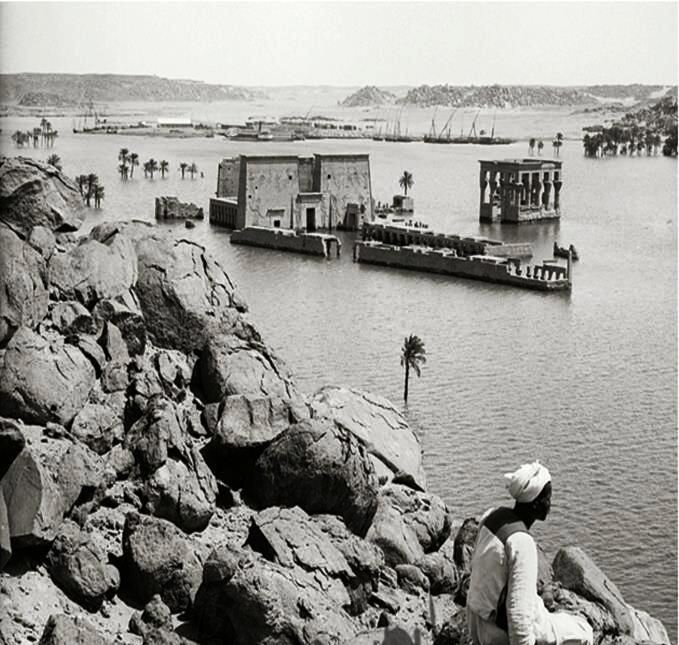
Threats to the temple's preservation, including the building of the Aswan Dam and subsequent relocation efforts
Threats to the Preservation of the Philae Temple
The construction of the Aswan Dam posed a significant threat to preserving the Philae Temple and other ancient structures in the area. The dam was built in the 1960s to control the flooding of the Nile River and generate hydroelectric power. However, the dam caused the surrounding areas to become submerged, including the island of Philae, where the temple was located.
An extensive relocation project was undertaken to save the temple from being permanently submerged. The temple was dismantled piece by piece and relocated to the nearby island of Agilkia. This relocation effort was an international collaboration involving UNESCO and various Egyptologists and archaeologists. The temple was carefully reconstructed on Agilkia Island, preserving its original layout and architectural features as much as possible.
While the relocation saved the temple from destruction, it still posed challenges to its preservation. The temple had to endure exposure to the elements during the dismantling and reconstruction process, which caused some damage to the original carvings and reliefs. Additionally, the change in environment and exposure to different climatic conditions on Agilkia Island could potentially affect the long-term preservation of the temple.
However, efforts have been made to mitigate these threats and safeguard the temple's preservation. Preservationists continue to monitor and maintain the temple to ensure its protection from potential damage caused by environmental factors or human activity. The temple's status as a UNESCO World Heritage Site has also helped raise awareness about its significance and the need for its ongoing preservation.
Despite the threats it has faced, the Philae Temple remains a remarkable testament to ancient Egyptian history and continues attracting visitors worldwide. Its relocation and preservation efforts serve as a reminder of the dedication to preserving cultural heritage for future generations to appreciate and learn from.

Rediscovery and Restoration
Exploration and documentation of the temple by archaeologists and preservationists
Exploration and documentation of the Philae Temple have been monumental tasks undertaken by archaeologists and preservationists over the years. This beautiful temple, located on the island of Philae in Egypt, has attracted scholars and researchers from around the world eager to uncover its secrets and preserve its historical value.
Archaeologists have conducted extensive excavations in and around the temple, unearthing a wealth of artefacts and inscriptions that shed light on the temple's construction, religious rituals, and the daily lives of the ancient Egyptians. These discoveries have provided invaluable insights into the significance of the temple and its role in ancient Egyptian society.
Preservationists have also played a crucial role in documenting and protecting the temple. The delicate and intricately carved reliefs and carvings within the temple have been meticulously recorded and studied, ensuring their beauty and historical value are preserved for future generations.
In recent years, advanced imaging technologies such as photogrammetry and 3D scanning have been used to create detailed digital models of the temple. These digital replicas allow researchers and visitors to explore the temple virtually and gain a deeper understanding of its architecture and design.
Moreover, efforts have been made to restore and conserve the temple to its former glory. Conservation teams have worked tirelessly to stabilize the temple structure, clean and repair the intricate carvings, and protect the temple from the elements.
Thanks to the dedication and hard work of archaeologists and preservationists, the Philae Temple has survived the challenges it has faced and continues to be a remarkable testament to the ancient Egyptian civilization. It is now open to the public and recognized as a UNESCO World Heritage Site, attracting visitors from around the world who are eager to witness its beauty and learn about its rich history.
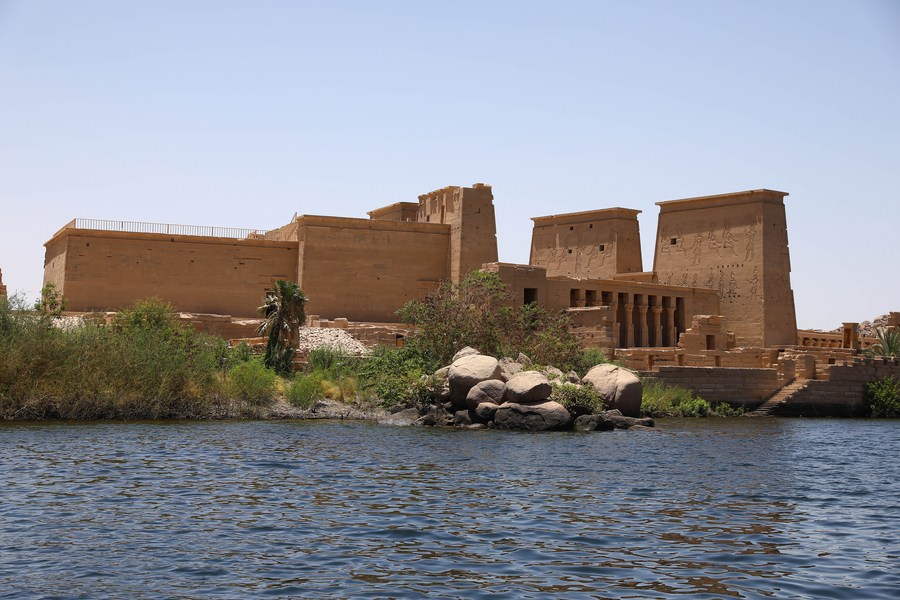
Philae Temple Today
The temple's reopening to the public and its status as a UNESCO World Heritage Site
In recent years, the Philae Temple has again opened its doors to the public, allowing visitors to marvel at its remarkable beauty and rich history. After an extensive restoration and relocation effort in the 1970s, the temple was officially reopened to visitors in 1980. Today, it stands as one of Egypt's most popular tourist attractions, drawing people worldwide to experience its enchanting ambience and architectural splendour.
The United Nations Educational, Scientific and Cultural Organization (UNESCO) recognised the temple's significance and cultural value as a World Heritage Site in 1979. The UNESCO listing ensures the protection and preservation of the temple, safeguarding it for future generations to appreciate and study. This prestigious status highlights the temple's universal value as an emblem of Egypt's ancient civilization and its contribution to human history.
As a World Heritage Site, the Philae Temple is subject to strict regulations and conservation efforts to maintain its authenticity and integrity. Various measures are in place to protect the temple from environmental deterioration, such as controlling visitor access and monitoring the impact of tourism. Additionally, ongoing research and documentation projects are conducted to deepen our understanding of the temple's significance and aid in its preservation and interpretation.
The reopening of the Philae Temple and its recognition as a UNESCO World Heritage Site allows visitors to experience the splendour of ancient Egypt but also promotes cultural exchange and appreciation of our shared human heritage. It serves as a reminder of ancient civilisations' power and enduring legacy and their continued relevance in shaping our world today.
